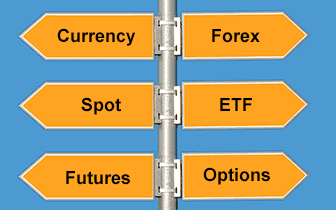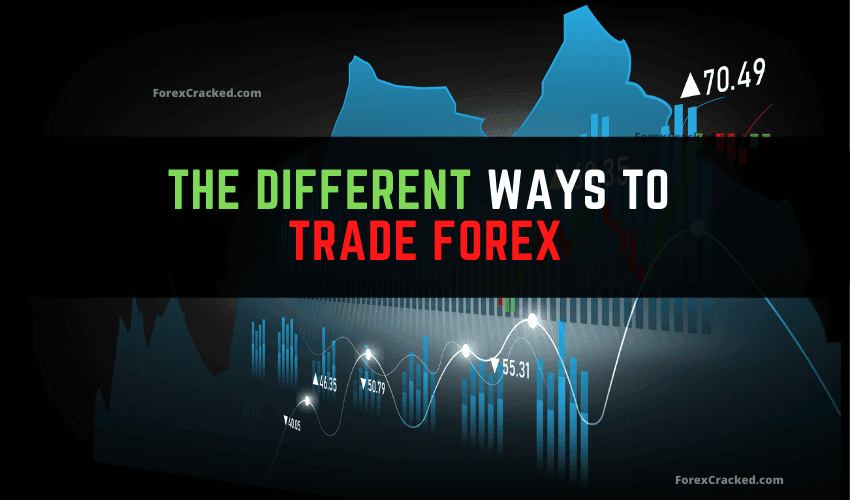Traders have come up with various techniques to invest or speculate in currencies because forex is so great. The most popular financial tools are currency futures and options (CFOs), currency ETFs (or exchange-traded funds), forex CFDs, and spread betting. Individual (“retail”) traders can trade foreign exchange in various ways, which we’ll go over in detail.

Because institutional investors use these instruments, they are not included in this list.
Now that we’ve cleared things up, let’s talk about how you may get involved in the forex market and the different ways to trade forex.
Futures on currency
Futures have contracted to buy or sell a specific asset at a predetermined price later. It is possible to buy or sell a currency future at a predetermined price and date.
The Chicago Mercantile Exchange (CME) was the first to introduce currency futures in 1972 when bell-bottoms and platform boots were still fashionable.
For this reason, the market for futures contracts is extremely well-regulated and transparent. Price and transaction data can be accessed at any time.
Alternatives for the Exchange Rate
At the time of expiration, the buyer has the option, but no obligation, to buy or sell an asset at a defined price. This type of financial instrument is known as an “option.” A trader who has “sold” an option at the expiration date is obligated to buy or sell a certain asset at the specified price.
Options are traded on exchanges like the Chicago Mercantile Exchange (CME), the International Securities Exchange (ISE), and the Philadelphia Stock Exchange (PSX), just like futures (PHLX).
Although trading FX options has its drawbacks, the market hours are limited, and the liquidity is not nearly as high as in the futures or spot market.
A currency ETF
Investing in a currency ETF allows investors to have exposure to a certain currency or a group of currencies.
Currency ETFs are a convenient way for retail investors to participate in the foreign exchange market without taking on the risk of making individual deals
Created and administered by banks, ETFs invest in a portfolio of currencies. Once the fund shares are available to the general public, they can be bought and sold on an exchange, exactly like stocks.
Unlike currency options, trading currency ETFs has the same drawback: the market is not open around the clock. There are other charges associated with trading ETFs.
Spot FX is a trading platform
When it comes to the spot foreign exchange market, it’s known as an “OTC” market or an “off-exchange” market. Foreign exchange trading that takes place off-exchange is a thriving, ever-expanding, and always-open financial market.
Because there is no central trading place or “exchange,” it is not a stock market. A customer trades directly with a counterparty in an OTC market. Spot FX contracts are not traded on centralized exchanges like currency futures, ETFs,
or (most) currency options (private agreements between two parties).
Electronic trading networks are used for most transactions (or telephone).
Forex traders trade with each other in an “interdealer,” or “interbank,” market. Whenever a customer needs to buy or sell currency, the dealer is ready to act as their agent.
Due to banks’ prominence as foreign exchange dealers, the interdealer market is sometimes known as the “interbank” market.
To participate in the interdealer market, an institution must trade big volumes and have a large net worth. Several big financial institutions deal with currency rate variations, including banks, insurance firms, pension funds, corporations, etc.
An institutional trader buys and sells a contract to make or take delivery of a currency in the spot FX market. An agreement to physically exchange one currency for another is known as a spot FX transaction, and it is made on a
bilateral (“between two parties”) basis.
This agreement is a contract. If the “spot exchange rate” or current exchange rate is used, then this spot contract is a binding obligation to buy or sell a particular amount of foreign currency at that current price.
When you buy EUR/USD on the spot market, you are trading a contract that guarantees you a certain quantity of euros in return for US dollars at an agreed-upon price if you do so (or exchange rate).To avoid confusion, it’s vital to note that you’re not trading the currencies themselves but rather an agreement that incorporates the currencies.
Even though it’s termed “spot,” transactions aren’t truly resolved “on the spot.”
Realistically, even if a spot FX exchange is resolved at today’s market rate, it takes two business days to complete the transaction.
“Today plus two business days” is referred to as “T+2”.Value date, often known as the delivery date, refers to a deadline of two working days for receiving your purchased or sold goods.
Consider the case of an institution purchasing EUR/USD on the spot foreign exchange market.
On Wednesday, the value of the trade opened and closed on Monday will be calculated. Euros will arrive on Wednesday as a result of this change. There are certain exceptions, however.
Examples of currency pairs with T+1 value dates include the US dollar (USD), the Canadian dollar (CAD), the Turkish lira (TURK) (USD), and the Philippine peso (USD) (T). Trading in the actual spot FX market is NOT where retail traders trade, though.
Forex trading on the internet
Through the OTC market, traders of all income levels can participate in the forex market. So-called “forex trading providers supply access. “
The primary OTC market is where forex trading companies trade on your behalf. Before presenting the prices on their trading platforms, they locate the lowest accessible pricing and apply a “markup.”
Retail stores buy wholesale inventory, mark up the price, and then display a “retail” pricing to their clients.
Even though a two-day delivery window is standard for spot forex contracts, no currency is ever delivered in practice.
The delivery date is “rolled” into the position.
The retail FX market is a good example of this.
Remember, you are essentially trading a contract to deliver the underlying currency rather than the currency itself.
In other words, it’s a contract with added leverage.
Leveraged spot forex contracts cannot be “taken or delivered” by retail forex dealers. Leverage gives you the power to manipulate enormous sums of money with only a little outlay of cash.
Because retail forex brokers allow you to trade with leverage, you can open positions worth 50 times the originally needed margin.
So if you have $2,000, you may open a EUR 100,000/USD transaction.
Imagine having to deliver Euros worth $100,000 as part of a short position on EUR/USD!
You can’t pay for the contract in cash because you only have $2,000 in your account. You would be unable to complete the transaction due to a lack of funds.
Because of this, you must either close the deal before it settles or “roll” it over to the next day. To avoid the hassle of delivering a physical package, retail forex brokers automatically “roll” customer positions.
Read Previous Lesson: Forex Market Size And Liquidity



muy buen articulo… Gracias